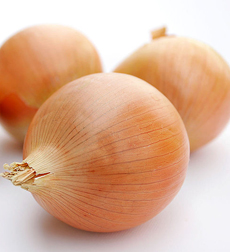TIP OF THE DAY: Which Onion To Use For What
|
The different types of onions are not universally interchangeable. When a recipe calls for “an onion,” it would be helpful to know which one of the common onions—red, sweet, white or yellow—you should use.
Yes, the recipe will still work if you use a yellow onion instead of a red onion; but using the right onion for that recipe will produce the flavor that the recipe writer intended. Here are tips from Katie Waldeck, one of our favorite food writers. They are adapted from her original article on Care2.com. TYPE OF ONIONS & HOW TO USE THEM Red Onions Red onions tend to be pungent and spicy for most of the year; the fresh summer red onions are much more mild. They are best used raw. If you find the taste too sharp, soak the sliced onions in water for 30 to 60 minutes (this works for any type of onion). |
The most colorful onion, the red onion. Photo courtesy Burpee.com. |
|
|
Use Them For: burgers, pickling, salads, salsas, sandwiches. Sweet Onions Sweet onions tend to be larger, with thinner skin. Familiar varieties include Maui onions, Texas sweet onions, Vidalia onions and Walla Walla onions. The sweetness is largely due to the low-sulfur soil in which they are grown. Sweet onions have minimal pungency and can be eaten without fear of “onion breath.” However, they break down quickly in cooking and aren’t very complex in flavor, so they should not be used in place of yellow onions. Unlike other varieties, sweet onions spoil quickly and should be stored in the fridge. Use Them For: gratins, grilled/roasted vegetables, onion rings and any raw uses (see uses for Red Onions, above). |
||
 The kitchen standard, the yellow onion. Photo courtesy Flagstaff Fotos. |
Yellow Onions
This “standard” onion is usually the least expensive variety. If the recipe doesn’t specify a type of onion, a yellow onion is your best bet. Yellow onions have a complex and spicy flavor, but they have more sulfur than other onion varieties, so they’re much more pungent and tear-inducing and can be overly assertive for eating raw. They are particularly hardy and keep for a longer time than other varieties. Use Them For: Dishes that cook for a long time on low heat: sauces, soup, stews, stocks, risotto, sautéed onions. White Onions Sharper than yellow onions, crisp and clean in flavor, white onions can be used both raw and cooked. Cook them as you would yellow onions, serve them raw as you would red onions. White onions have a slightly shorter storage life than yellow onions. |
|
|
Use Them For: Mexican food (including chili), white sauces and for the raw uses above. Onions should be stored in a cool, dry place away from light, with the exception of the more fragile sweet onions, which should be stored in the fridge. Here are seven ways to slice onions.
|
||



